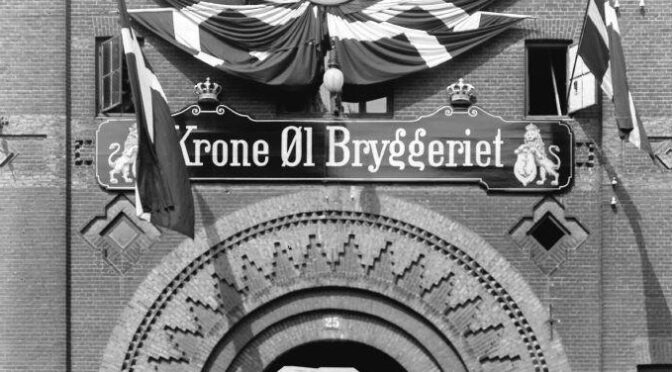While browsing Gambrinus (an old Austrian brewing industry newspaper), I came across an article discussing Danish temperance beers. At the time, Denmark had a significant amount of distilled spirit consumption (14.57 liters per capita per annum, allegedly the highest in the world at the time, compared to 9.8 liters in Austria-Hungary) as well as a significant beer consumption (91.39 liters, compared to 41.2 liters in Austria-Hungary) that was allegedly only topped by Belgium, the UK and Germany at the time.
In this environment, lower alcohol beers, so called temperance beers, were made tax-free: if a beer had less than 2.25% (the article isn’t clear whether this is by weight or by volume), no duty had to be paid on the beer itself.
Interestingly, these beers were brewed top-fermented, using different methods. The first method was to use a low-gravity wort that was then fully fermented, while the second method involved a regular-gravity wort that was fermented but fermentation was stopped early to only achieve a low attenuation. The article then compares the analytical data of five of these Danish temperance beers with the same data of a Viennese Abzugbier and a Bohemian Schankbier (výčepní).
Mörk Carlsberg Skattefri (Dark)
- OG 7.47° Balling
- Residual Extract 2.73°
- Alcohol 1.92%
- Apparent Attenuation 63.46%
Lys Carlsberg Skattefri (Pale)
- OG 6.40° Balling
- Residual Extract 1.71°
- Alcohol 1.90%
- Apparent Attenuation 73.28%
Aegte Kroneoel
- OG 11.36° Balling
- Residual Extract 7.51°
- Alcohol 1.56%
- Apparent Attenuation 33.89%
Export Dobbeltoel
- OG 14.68° Balling
- Residual Extract 10.90°
- Alcohol 1.53%
- Apparent Attenuation 25.75%
Krone Pilsener
- OG 9.48° Balling
- Residual Extract 5.76°
- Alcohol 1.51%
- Apparent Attenuation 39.24%
Wiener Abzugbier
- OG 10.04° Balling
- Residual Extract 3.46°
- Alcohol 2.42%
- Apparent Attenuation 65.54%
Böhmisches Schankbier
- OG 10.09° Balling
- Residual Extract 2.66°
- Alcohol 3.02%
- Apparent Attenuation 73.63%
In another article in Der Böhmische Bierbrauer from 1906, Krone-Oel-Bryggeriet is discussed in greater detail. They started brewing tax-free beers with the Kroneoel in 1895. Because of the product’s great success with just 1.5% alcohol by weight, a second product, Krone Pilsener was added in 1899, which was designed to be paler and lighter in original gravity, with a fine, mild hop bouquet. Just a year later, the portfolio was extended with Export Dobbeltoel, a dark beer very high in extract.
The popularity of these tax-free beers (this article is clearer, they must have less than 2.25% alcohol content by weight in order to be tax-free) shows in the sales figures:
- 1895/1896: 2,918,508 half liter bottles
- 1896/1897: 5,702,032 -“-
- 1897/1898: 7,750,032 -“-
- 1898/1899: 9,281,958 -“-
- 1899/1900: 10,018,905 -“-
- 1900/1901: 10,939,750 -“-
- 1901/1902: 11,430,867 -“-
- 1902/1903: 13,638,806 -“-
- 1903/1904: 13,665,237 -“-
- 1904/1905: 14,704,359 -“-
That is an astonishing increase of the sales volume by 503% over the course of just 10 years, from 29,185 hl to 147,043 hl per year. For comparison, Kleinschwechater Brewery from Austria, one of the largest European breweries at the time, produced 441,490 hl of beer in 1905. Producing a third of that volume just in bottled low-alcohol temperance beer seems quite a feat.
After reading about Danish tax-free beer, naturally I wanted to know more about. After some searching I found this Facebook post that gives a brief overview over it. According to the article, in 1891 the first beer tax law was introduced in Denmark (please note that this was not actually the first beer tax law in Denmark, as the situation is a lot more complicated; in Beer and Brewing in Pre-Industrial Denmark by Kristof Glamann, taxation of beer in Denmark is attested at least since the 1620s). It divided beer between tax-free beers (under 2.25% ABW) and taxable beers. In 1917, this was further revised and only top-fermented beers remained tax free, while other types of beer under 2.25% ABW were put into tax class 2. Previously taxable beers were put into tax class 1.
During World War 1, breweries were restricted how strong beers could be. These restrictions were lifted in 1923 and taxation was again revised. In particular, tax class 1 was divided into 3 sub-categories: the new tax class 1 consisted of all beers with no more than 10.75 °Balling original gravity, tax class A more than 10.75° Balling and up to 13° Balling original gravity, and tax class B consisted applied to all beers with more than 13° Balling original gravity. The new classes 1, A and B again only applied to beers with more than 2.25% ABW, so low alcohol beers could have a higher OG without getting taxed. This was again only revised in 1993 to have different brackets of OG (<2.25% ABW/2.8% ABV beers still remained tax-free), and again in 2004 when it was changed to a sliding scale system (<2.8% ABV beers still tax-free).
Even though the “skattefri” category of beers doesn’t seem to be as obviously prominent in the Danish beer market, it still exists in tax law.

